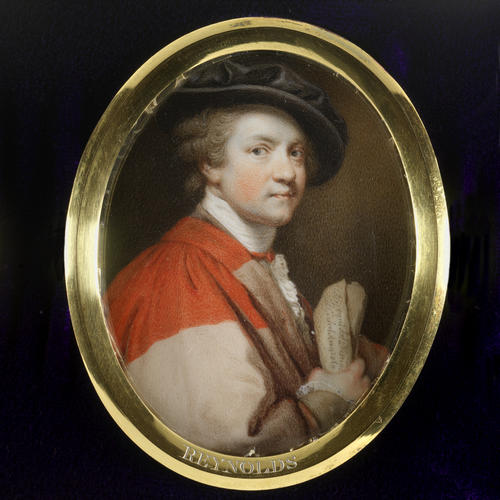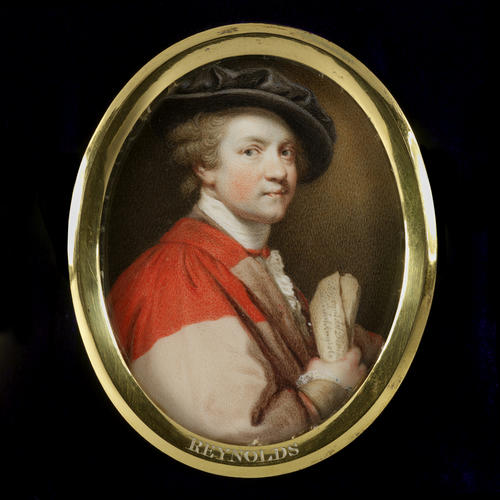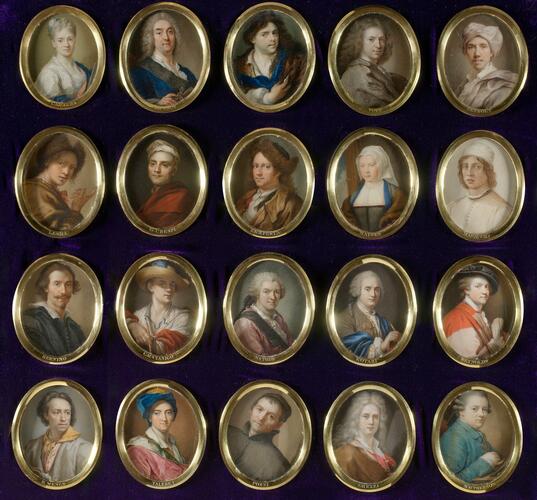Sir Joshua Reynolds (1723-1792) c.1772-80
6.9 x 5.3 cm (sight) | RCIN 421250
-
Sir Joshua Reynolds was an English painter and writer on art, the leading portraitist of his day and the first president of the Royal Academy. He was the son of a clergyman and from 1740 to 1743 studied painting in London with Thomas Hudson, then set up independently as a portraitist. From 1750 to 1752 he was in Italy, mostly in Rome where he studied the Antique and made copies of paintings by the great masters. He believed portraiture should make reference to great art of the past, so when he returned to London in 1753, his portrait of Commodore Keppel (London, National Maritime Museum) was based on the Apollo Belvedere. By 1758, Reynolds had 150 sitters a year and by 1764, was earning £6,000 a year – an enormous sum.
He was friends with Samuel Johnson and Oliver Goldsmith and when he was appointed president of the Royal Academy, arranged for them to be appointed professors of ancient history and literature. The 15 lectures or Discourses which he gave to Academy students established the principles of the Grand Manner, or elevated style of history painting. He encouraged artists to learn from past masters and to idealise nature, and to devote themselves to morally elevating subjects. The honour Reynolds perhaps valued most was the doctorate of civil law awarded him in July 1773 by the university of Oxford, the gown for which he is wearing in this portrait. 'Distinction', Reynolds affirmed, 'is what we all seek after, and the world does set a value on them [sic], and I go with the great stream of life'. In 1789, his eyesight began to fail and he was forced to give up painting. He was buried in St Paul's cathedral with ceremonial that no British painter had received before. His pall bearers were three dukes, three earls, two marquesses, a viscount and a baron.
This miniature is one of the collection of copies of 224 self-portraits by artists in the Uffizi Palace, Florence, that Lord Cowper, the art collector and patron, commissioned Giuseppe Macpherson (1726-1780) to paint. He presented the miniatures to King George III in two batches, in 1773 and 1786. Macpherson followed the original self-portraits quite closely, but copied only the head and shoulders. He inscribed the artists' names on the backs of the miniatures – several differ from those in the modern Uffizi catalogue, notably: Bazzi, Bellini, Campi, Annibale Carracci, Gabbiani, Masaccio, Metsys, Moroni, Pencz, Licinio, Schiavone and Spada. None of the miniatures is signed, apart from Macpherson's own self-portrait, which is inscribed: Giuseppe Macpherson / Autore della serie (Giuseppe Macpherson / Author of the series).Macpherson was born in Florence, the son of Donald Macpherson, a footman in the service of Alexander, 2nd Duke of Gordon. He was a pupil of Pompeo Batoni and painted miniatures and enamel portraits in Italy, France and Germany, finally settling in Florence. A James Macpherson is recorded in London and Paris in 1754 but it is not certain that this is the same person. He was described in 1776 as having a special talent for painting on enamel and as being 'almost the only painter in Europe who possesses this art to perfection'. He had a distinguished client list which included some of the crowned heads and dignitaries of Europe. In 1778, he was invited to add his own self-portrait to the famous painters in the grand duke's collection as it 'would do honour to Florence to enrich the collection with a work which shows that we still have some men of true merit' according to Giuseppe Pelli, director of the Uffizi at the time.
Provenance
Presented to George III by Lord Cowper
-
Creator(s)
-
Medium and techniques
Measurements
6.9 x 5.3 cm (sight)
Other number(s)
RL 01.8/15











